Are Imports Better Than U.S. Cars?
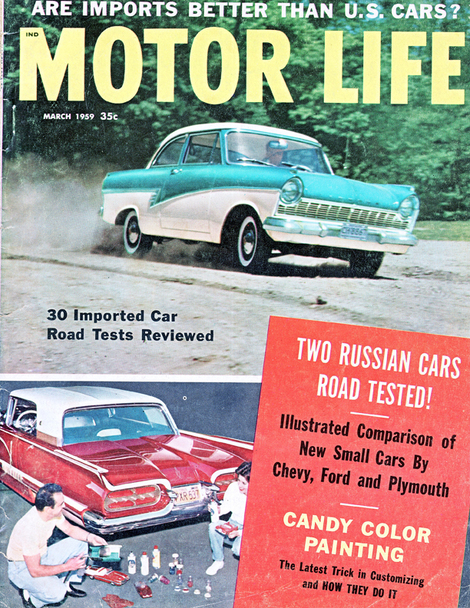
**It is fascinating to see what kinds of cars were being imported in 1959. I certainly remember some of them from my childhood but not all. You have to remember that there were very few imports on the road at this time and Americans had not yet embraced this concept. American makers were at this time considering the first compact (small car) cars - Chevrolet, Ford Junior, Ford Senior, and Plymouth were starting production on the first small cars. It would appear that some sports car models though are not represented for criteria reasons. Perhaps it was the imported numbers or price considerations probably the economic family friendly models.**
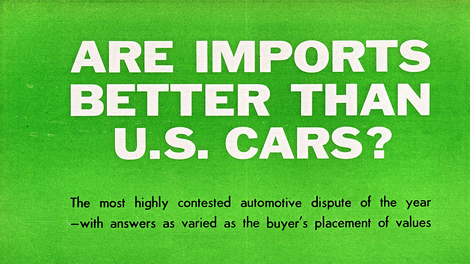
Are Imported cars better than U.S. cars? This is a loaded question and not really a fair one. It's asked and debated so often these days, however, that it deserves examination - if not a definitive answer.
First difficulty is establishing a basis for comparison. Many types and makes of foreign cars are sold in this country, from mini-cars and small family sedans to sports models and even expensive luxury sedans.
For the purposes of argument, this must be narrowed down. This discussion will be confined primarily to what might be called economy family cars, plus some of the other less esoteric models, which make up the bulk of imported sales.
Second problem is defining what is meant by "better". There are many facyors involved in evaluating a car or cars and the weight given each one varies with individual tastes, needs and desires.
A basic yardstick of measurement is overall value. In cars this involves initial and operating costs, resale value and life expectancy. Imported car proponents have some telling arguments concerning value; also some vulnerable areas.
Fuel economy of the type of imports we're talking about is unquestionably better than that of the average U.S. cars.
First cost of most of the popular foreign makes generally lower, although there is not too big a gap between some of them and discounted prices of some of the least expensive Big Three makes. Rambler and Lark compete directly with a good many imports.
High resale value has been an important asset to popularizing imports and adding to their basic value. How long they will hold up as well in the future is uncertain. As more imports become available on the second-hand market, resale value will undoubtedly slip.
This has already happened in some cases. It isn't easy to drive an import for a year and sell it for only $50 or $100 less than the original purchase price except in isolated cases - and this was common not too long ago.
More stable design policies and the fact that Imports are likely to continue to represent only a small percentage of total cars in this country, however, should keep import prices on a favorable level compared to American cars.
Lower servicing costs are generally claimed for imports, but there is room for debate here. Their ease of servicing is often offset by the fact that they require more frequent attention to keep them in peak tune.
Nor does simpler, easier servicing mean lower labor costs. A shortage of competent foreign car mechanics in many areas means they often command premium wages, wiping out theoretical savings in service bills.
Parts are not only hard to get at times but often are higher priced than similar parts for U.S. cars - result of lower production volume and high shipping costs.
It's too early to know for certain how imports compare with U.S. cars in life expectancy: not enough have been coming here for a sufficient time. There is a strong suspicion that many makes won't last as long as U.S. cars under typical American driving conditions.
This treason will bring howls of anguish from foreign car enthusiasts, but seems probable. Small car engines and drive lines work harder than those in U.S. cars; in the main, they are less tolerant of abuse than Detroit products - and American car owners generally don't treat their automobiles with the repect and loving care of owners abroad.
Roadability of most imports admittedly is superior to that of the average American car - although a car is not necessarily outstanding in this respect just because it's shipped here by boat! Many imports have outstanding handling qualities; some are only ordinary or less. (Stock VW's for instance exhibit alarming characteristics under some conditions.)
Compact size does give foriegn makes an intrinsic edge in maneuverability, however.
In riding smoothness and comfort U.S. cars have just as clear an edge. True, there are imports with excellent riding qualities, but generally they are the more costly ones. Dollar-for-dollar few ride as comfortable as domestic cars.
Quality ia a distinct imported car asset. There is little doubt more careful craftsmanship goes into the average import as compared to the average U.S. car.
Again, this shouldn't be interpreted as a sweeping accolade to all foreign makes. Glaring flaws show up in some and defects crop up even in makes especially known for their workmanship. In general however, imported car quality is better in most American cars.
Performance is a real U.S. car strong point. Imported car fans can talk about relative performance in terms of engine size all they want, but this doesn't change the fact that Detroit makes are quicker in all respects.
Whether or not all this performance is necessary is another story. The many valid arguments pro and con have been rehashed so often there is little point in bringing up here. There is little doubt though, that a reasonably high level of performance is pretty close to a necessity for many type of American driving.
More than a few imports fall below this level and are definitely not suited to long distance driving where bursts of speed for passing are needed. It might be going too far to say they are not safe, but some imports are close to the danger point.
Luxury of appointments, extensive arrays of convenience accessories and flamboyant styling are special characteristics of American cars. There can be no question that few foreign cars match them in these areas; fewer still come near at comparative costs. (The question of whether or not this helps them "better" is another matter and depends strictly on individuals.)
This matter of specific national characteristics of cars is interesting and bears on relative worth.
*German *cars tend to have stolid, functional styling devoid of flash and glamor, but are renown for high quality.
French cars as typified by Renault and Simca, lean toward clever and or unusal design; often with advanced engineering. Detail finish is not always on the same high plane.
*Italian *cars are unquestionably the style leaders, offer extremely good roadability - needed at home because Italy's roads and terrain and enthusiastic Italian driving habits!
British excel in sports car designs, are less sucessful in building small and medium sedans. With a few exceptions, English family cars are more notable for sound mediocrity than outstanding features. Styling tends to be a hodge-podge of conservatism and copies from other countries.
Swedish cars, Saab and Volvo have dated styling strange to American eyes - make up for it with excellent performance and high caliber workmanship.
In general then, it might be said that imports are more sensible than U.S. cars in that they avoid many of the excesses prone to American automobiles. On the other hand, imports can't fill all the needs of all U.S. drivers - or, if not the needs, at least the desires. Only individuals can give a flat yes or no as to whether imports are better.
One thing we must thank imported cars for, however, is that ot looks like they are helping to bring about changes in the thinking which can't help but improve U.S. cars in the future.
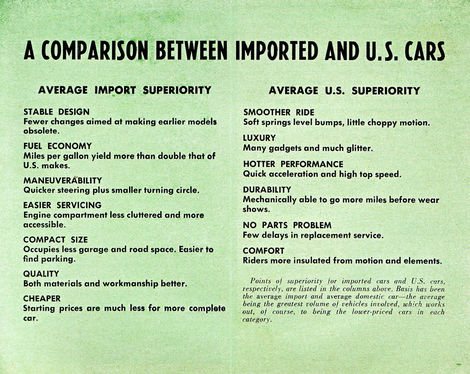
On to the road tests - which again are for the most part cars of a family nature or at least similar price point.
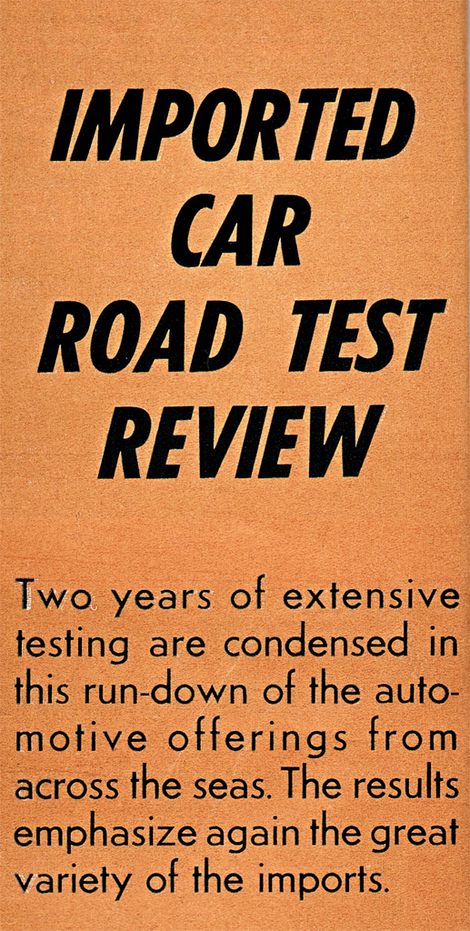
Imported cars have become an increasingly important part of the U.S> automobile scene in the past few years - and Motor Life's coverage of them has kept pace.
With interest in foreign automobiles currently at an all-time peak. it seems to be a good time to take a second look at the wide variety of vehicles road-tested during the past two years.
And variety it has been! Emphasis has been principally on sedans priced within shooting distance of $2,000 and suitable for a family car use, but the range included everything from the $1095 BMW betta bubble-car up to the Jaguar 3.4 sedan.
In retrospect, it seems this variety of choice has been an extremely significant factor contributing to sales successes of imported automobiles.
Certainly no comparable choice has been available in domestic car field. With few exceptions, American cars differ mainly in degree and detail rather than in basic function. This isn't necessarily bad: it reflects the need to produce in huge volumes automobiles for which the masses had indicated preference.
This has left the field open for imported makes to cater to individuals looking for something different to satisfy their particular needs, tastes, and desires. And the cars shipped to this country from overseas have been just as individualistic as the people buying them.
This is obvious from the pictures, specifications and concise recaps of road tests on the following pages. More than just a review of Motor Life's experience with more than 30 imported cars during the past two years, this special section will serve as a guide to cover the essentials of the more popular foreign makes and a shopping guide for those considering purchase of an import.
One thing that does become apparent in studying the imported car field closely is that the laws of compromise, of give-and-take, apply abroad just as they do in this country.
There is no such thing as the perfect automobile; one that is all things - and all of them good - to all men? This was proven during the testing of these automobiles. These were many times when test crew members, all experienced automobile men, were in disagreement about the overall worth of a car or its specific features.
This is not surprising and is the reason why a number of different impressions and opinions are recorded by the crew members, then weighed and analyzed before an overall report is complied on each test car.
(If everyone thought alike and had the same idea of what an automobile should be, the job of designing cars would be much less complicated - but that isn't the way human nature works!)
Several cars deserve to be cited for various outstanding qualities. It should be noted, however, that the 30 cars tested and reviewed do not include all imports - which may eliminate one good import or another from mention here. But every imported car marketed in the U.S. in substantial quantity has been covered.
In the small sedan class value is the greatest virtue any car can have, since it reflects all-round qualities that buyers seek. Four imports have set the standard in this respect; they are Volkswagen, Renault, Dauphine, Peugeot, and the Fiat 1100, amoung the cars tested. Another car high on an all-round scale is the Hillman Special.
In a specialized sense the Mercedes must be cited for it's luxury and quality of manufacture.
The Volvo stands out for the terrific performance it gets from a relatively small engine of very conventional design. The Simca is remembered as an outstanding performance in its slightly smaller displacement class.
The VW Mirco Bus for its cavernous capacity; truly amazing in such a compact vehicle. The 3.4 Jaguar is remembered because it proved a car needn't be bulky to be comfortable, luxurious, attractive, and quick.
Such mini-cars as the Isetta and Goggomobil were more notable for their novelty then because of any feeling that they fill a volume need in the country for such minimal transportation.
In examining the road test summary of the Renault Dauphine, on the following pages, it should be kept in mind that it alone was checked for gas mileage at steady speeds. All other cars were reported in this category by tank averages for normal driving. The steady speed fuel test; naturally, resulted in a substantially higher figure.
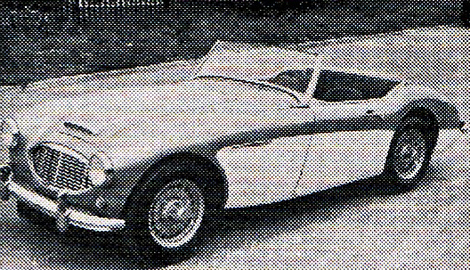 Austin-Healey 100 (current price $3,087 N.Y. POE)
Austin-Healey 100 (current price $3,087 N.Y. POE)
Sports cars fans in the Untied States owe a tremendous debt to England. Well-heeled enthusiasts might be able to pay for expensive Italian jobs, but it's the likes of Austin Healey, Triumph, and MG which keep most of us going. The A.H. 100 with its six-cylinder engine and squeeze-in room for a couple of kids behind mom and pop has done more than its share to bring fun motoring to the American masses. It has a healthy enough engine - 161 cubic inches, 102 hp - to stay with Detroit jobs under all conditions and handling qualities which enables it to run away and hide from stock U.S. sedans in anything but turnpike driving! Nor need it be raced to be enjoyed: "you can drive this car for incredible distances without becoming tired," reported the test crew after checking it out. Couple this with gas consumption of 17.18 mpg and better and it's easy to see why the A.H. 100 is always in demand.
Model - 1958 roadster, six-cylinder ohv, water-cooled, 161 cubic inches, 8.25 to 1 compression, 102 hp @ 4600 rpm, curb weight 2,352 lbs, wheelbase 92 inches, 4 speed transmission.
Performance figures - gas milage 17.7 mpg, acceleration 0-30 mph 4.6 seconds, 0-45 8.1 seconds, 0-60 12.7 seconds
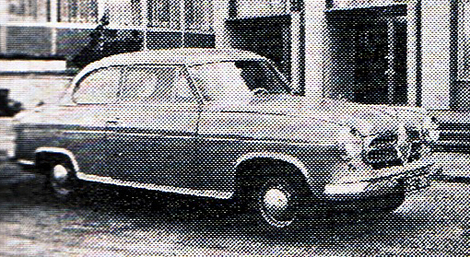 Borgward TS (current price: $2,845 N.Y. POE)
Borgward TS (current price: $2,845 N.Y. POE)
Expensive in a relative sense, but woth it in terms of performance, quality, and economy - that's the best way to sum up the Borgward TS. Like most German cars, it is well-made - if not beautiful! Its independent suspension on all four wheels gives it an admirable combination of fine handling qualities and surprisingly good ride for a 102-inch wheelbase automobile. The TS (touring sport) Borgward is not a family economy sedan in a true sense, but is especially attractive to discerning types looking for a drive-every-day car which is especially adaptable to various types of competition. Steering is quick - three turns lock-to-lock - and precise; brakes are excellent, though they require a fair amount of pedal pressure. In short, this is something of a connoisseur's automobile for those wise enough to understand that very good things can come in small high priced packages.
Model - sedan, four-cylinder ohv, wter-cooled, 91.1 cubic inches, 8.2 to 1 compression, 82 hp @ 5,500 rpm, wet weight 2,240 lbs, wheel base 102 inches, four speed transmission.
Performance figures - gas milage 27 mpg, acceleration 0-30 mph 4.9 seconds, 0-45 9.9 seconds, 0-60 15.9 seconds; top speed 92-95 mph.
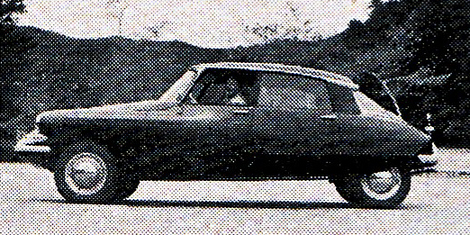 Citroen ID-19 (current price $2,795 N.Y. POE)
Citroen ID-19 (current price $2,795 N.Y. POE)
Only a bit less radical in design, the Citroen ID-19 is certainly one of the most unusual imported cars being sold in the U.S. Most interesting of its many advanced features is the suspension: all four wheels are spring independently by means of air-oil suspension units. Since the car has four-wheel drive and a front mounted engine, the floor is perfectly flat which adds to useful interior space. Styling is so offbeat that most people either like it very much or don't care for it at all: there is little middle ground. It definitely is distinctive, at any rate. The hydro-pneumatic suspension and very long wheelbase for a car of such compact overall length are major factors in providing riding qualities of exceptional smoothness, along with excellent roadability. Performance is not exceptional by comparison with other imports of like engine size, with more emphasis being placed on economy.
Model - four-door sedan deluxe, ohv, water-cooled, 116.6 cubic inches, 7.5 to 1 compression, 70 hp @ 4500 rpm, test weight 2,475 lbs, wheelbase 123 inches, four speed transmission.
Performance figures - gas milage 24 mpg, acceleration 0-30 mph 5.7 seconds, 0-45 10.8 seconds, 0-60 19.2 seconds; top speed 85.87 mph.
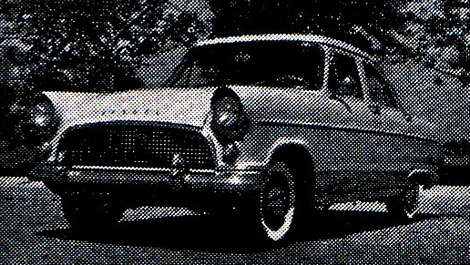 Ford Consul Mark II (current price $2,012 N.Y. POE)
Ford Consul Mark II (current price $2,012 N.Y. POE)
One of the more Americanized imports in its styling, this member of the English Ford family has more than a passing resemblance to its U.S. cousins of a few years ago. There is quite a difference in the handling qualities of the Consul as compared to American Fords - all in favor of the English- built automobile. Despite the fact that it has a larger engine, the Consul does not offer as good performance as a number of imported 1.5-liter sedans nor does it offer really outstanding fuel economy. This is because it is relatively heavy for its overall size. The four-cylinder Consul engine provides more low end torque than many imports, so demands less shifting of its three-speed transmission - another example of American influence. The car has roomy interior, can accommodate six without undue squeezing for anything but long trips. Trunk space is much more generous than in most imported cars in the Consul price range.
Model - 1958 Four-door sedan, four-cylinder ohv, water-cooled, 103.9 cubic inches, 7.8 to 1 compression, 59 hp @ 4200 rpm, test weight 2,540 lbs, wheelbase 104.5 inches, three-speed transmission.
Performance figures - gas milage 17.2 mpg (city) 22.2 mpg (highway), acceleration 0-30 mph 6.3 seconds, 0-45 12.9 seconds, 0-60 23.2 seconds.
 DKW (current price $2,195 N.Y. POE)
DKW (current price $2,195 N.Y. POE)
Two-cycle cars seem to have a couple of strikes against them to start with. Despite this, the DKW has done a very good job of winning friends and influencing buyers in the U.S. Not a volume seller in the sense of the VW and a few other popular imports, it has attracted enough customers amoung those looking for offbeat transportation to establish a steady - if unspectacular - market. The car itself performs amazingly well for its 54.7 cubic inches; will show its heels to cars with more than half again as much displacement in both acceleration and top speed. Handling is good by all standards, even if complicated by the forward weight bias caused by front-engine drive. The flat floor and excellent interior room made possible by this layout is a distant advantage. The relatively rough idle and the need for mixing gas and oil caused by the two-stroke engine hurt the car's sales chances somewhat. Study will show that there are advantages, which outweigh these inconveniences.
Model - 1956 hardtop coupe, three-cylinder, inline, two-cycle, water-cooled, 54.7 cubic inches, 7 to 1 compression, 42 hp @ 4200 rpm, dry weight 1,975 lbs, wheelbase 92 inches, four-speed transmission.
Performance figures - gas milage 30 mpg, acceleration 0-30 mph 5.5 seconds, 0-45 12.5 seconds, 0-60 24.8 seconds; top speed 75.78 mph.
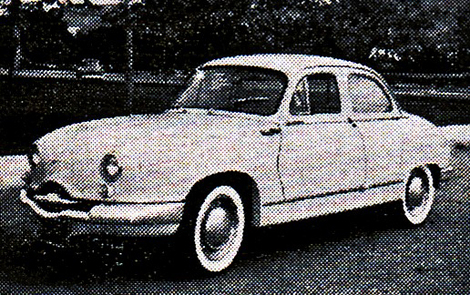 Dyan-Panhard (current price $1,995 N.Y. POE)
Dyan-Panhard (current price $1,995 N.Y. POE)
Noted abroad for out-standing competition successes in the small displacement class, the Dyan-Panhard is not so well known in this country. The model tested is typical of the marque, having an air-cooled opposed engine mounted in front and driving the front wheels. The two-cylinder powerplant develops 50 hp from 52 cubic inches displacement and furnishes the rather light sedan with performance better than a number of the larger-engined cars. Good fuel economy is indicated by the 35.1 mpg averaged by the Dyan-Panhard tested. An advanced suspension system helps give the car surprisingly comfortable riding qualities for its size. Handling is excellent, although those accustomed to more conventional designed automobiles will find the steering on the heavy side and will have to adjust their driving technique to cope with typical front-wheel-drive idiosyncrasies.
Model - 1958 four door sedan, two cylinder L-head, air-cooled, 51.93 cubic inches, 8.2 to 1 compression, 50 hp, curb weight 1,764 lbs, wheelbase 101 inches, four-speed transmission.
**Performance figures - gas milage 35.1 mpg, acceleration 0-30 mph 6.2 seconds, 0-45 12.8 seconds, 0-60 24 seconds; top speed 82 mph.
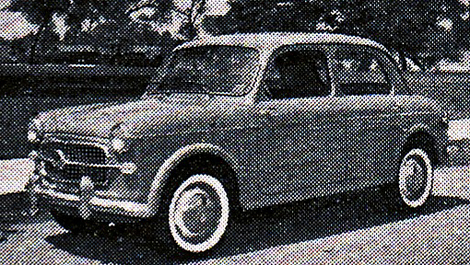 Fiat 1100 (current price $1,743 N.Y. POE)
Fiat 1100 (current price $1,743 N.Y. POE)
Quality of an outstanding degree was the major impression left with the road test crew by the Fiat 1100 sedan. Although a genuine economy vehicle, both in initial price and operating costs, the 1100 has a degree of finish "rarely found in domestic makes and not very often in imports." The car's fuel economy was about par for its engine displacement and overall weight; performance was a little better than par for its bracket. The 1100 typifies some of the reasons why Fiats are rapidly moving toward the top of the imported car popularity list in many sections. (The Fiat company's enlightened service and parts supply organization, as well as the products it builds, have helped win friends) No oddball in engineering or basic design, the Fiat 1100 might not have the sleekly good looks of more expensive, exotic, Italian cars - but uts practical appearance is backed up by equally solid functional characteristics.
Model - 1959 four-door sedan, four cylinder ohv, water-cooled, 40 hp @ 4,400 rpm, 7 to 1 compression, test weight 2,190 lbs, four-speed transmission.
Performance figures - gas milage 33 mpg, acceleration 0-30 mph 6.6 seconds, 0-45 13.2 seconds, 0-60 28.7 seconds; top speed 74.2 mph.
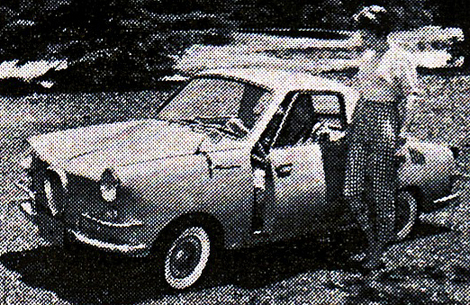 Goggomobil (current price $1,560 N.Y. POE)
Goggomobil (current price $1,560 N.Y. POE)
Novelty, economy, and roadability are three of the chief factors Goggomobil has going for it in an attempt to win a share of the increasing U.S. market for imported cars. Whether these are enough to counteract its extremely small size, low power and performance and relatively high price for the package involved is dubious; at least it doesn't appear that it can ever hope to sell in significant quantities. It is primarily suited to be a second car for the suburban housewife to use on shopping trips or alternatively, for automobile fans looking for a small "fun" car. The coupe tested displayed amazingly good handling qualities and a race between a batch of these little Goggos might be a lot of fun - to both watch and participate in. It is surprisingly roomy for two but, though it has back jump seats, it hardly qualifies as a family car.
Model - 1958 two-door coupe, two-cylinder air-cooled, 24 cubic inches, 6 to 1 compression, 20 hp @ 5000 rpm, test weight 1,014 lbs, four-speed transmission, 4.8 to 1 axle ratio.
Performance figures - gas milage 40 mpg, acceleration 0-30 mph 8 seconds, 0-45 17 seconds; top speed 65 mph.
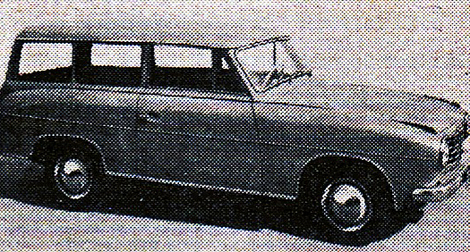 Goliath 1100 (current price $2,287 N.Y. POE)
Goliath 1100 (current price $2,287 N.Y. POE)
Recognizing that U.S. buyers are at best apathetic toward two-cycle engines, Goliath dropped the fuel-injected two-stroke powerplant it offered initially in this country in favor of a flat opposed four several years back. Front wheel drive has been retained however - despite the fact that the overhead valve engine now used is a water-cooled unit. This makes for quite an unorthodox automobile. The station wagon tested was particularly notable for the amazingly good ride it offered, considering its short wheelbase. With 30 mpg average fuel economy, very good performance in view of its engine displacement and the type of quality we have come to associate with German automobiles, Goliath 1100 has a lot to offer the thinking buyer. Only in terms of size-per-dollar does it fall down in fact: its price puts it right in the bracket of least expensive domestic Big Three models and above Rambler American and Studebacker Lark wagons.
Model - 1957 station wagon, four-cylinder ohv, 46 hp @ 4250 rpm, shipping weight 2,020 lbs, wheelbase 89.4 inches, four-speed transmission.
Performance figures - gas milage 30 mpg average, acceleration 0-30 mph 6.2 seconds, 0-45 14 seconds, 0-60 26.3 seconds; top speed 76 mph.
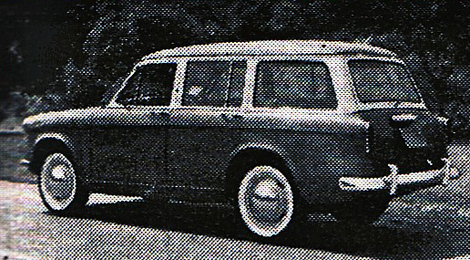 Hillman Minx (current price $2,299 N.Y. POE)
Hillman Minx (current price $2,299 N.Y. POE)
Not really outstanding in one definite area, English-built Hillman with buyers primarily on a good overall blend of qualities. One of the most attractive Hillman features is good styling; the make offers perhaps the best-looking British automobiles in its price class. Performance is about equal to that offered by most other makes of similar size and engine displacement. The Hillman tested a wagon, had rather heavy steering but this has been corrected by Hillman engineers. By virtue of its small size, the Hillman is an easy car to drive and offers good operating economy. Stiffer springs and an extra leaf in the Estate Wagon give it an even firmer ride than the Hillman sedans and amplify the car's bouncy quality; this is compensated for by surprisingly generous load carrying capacity and ability of the wagon to cope with weight overloads.
Model - 1957 Estate Wagon, four cylinder ohv, water cooled, 85 cubic inches, 8 to 1 compression, 51 hp @ 4400 rpm, dry weight 2,325 lbs, wheelbase 96 inches, four-speed transmission.
Performance figures - gas milage 26.4 mpg, acceleration 0-30 mph 6.3 seconds, 0-45 13.2 seconds, 0-60 23.7 seconds; top speed about 75-76 mph.
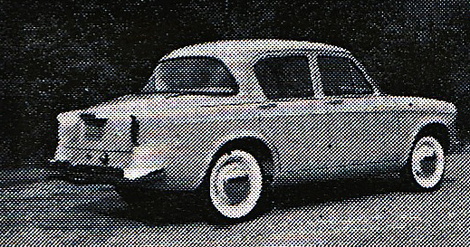 Hillman Minx Special (current price $1,699 N.Y. POE)
Hillman Minx Special (current price $1,699 N.Y. POE)
Comfortable, economical transportation are two of the chief virtues of the Hillman Minx Special, lowest-priced Hillman sold here in the U.S. It is $150 below the price of the Hillman Minx Deluxe sedan, yet has all the same essential features on the more expensive model. It differs only in that some interior and exterior details of trim have been eliminated and a floor-mounted shift lever instesd of the column lever used in the Deluxe model; changes are considered for the better by some buyers. In handling and roadability the car is outstanding, ranking high among imported sedans in this respect. Good interior and seat design add substantially to passenger comfort and help eliminate the cramped feeling back seat passengers often feel in larger cars.
Model - 1958 for-door sedan, four-cylinder ohv, water-cooled, 85 cubic inches, 8 to 1 compression, 51 hp @ 4400 rpm, test weight 1,858 lbs, wheelbase 96 inches, four-speed transmission.
Performance figures - gas milage 27.3 mpg, acceleration 0-30 mph 6.7 seconds, 0-45 14.4 seconds, 0-60 25.4 seconds.
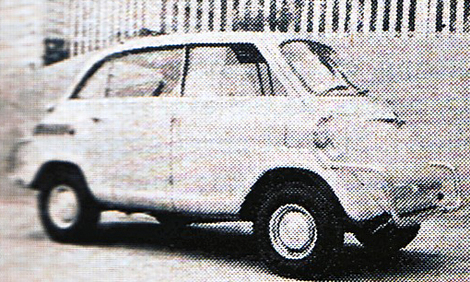 Issetta 600 (current price $1,298 N.Y. POE)
Issetta 600 (current price $1,298 N.Y. POE)
Those interested in minimal transportation for errand-type driving at lowest possible cost appear to constitute the major potential U.S. market for BMW Isettas. Two models, the 300 and the 600 (photo) are available. Most practical from American standpoint is the 600. Small as it is , this model is capable of carrying four (five in a pinch) adults, although rear legroom is definitely restricted. Performance naturally is poor, but not as much below, say, the VW as might be expected - and gas mileage is phenomenal. The test average of 38.1 mpg is below both factory claims and those of many owners and would probably be improved in non-test driving. The 300's advantages are lower first costs and better economy - but it can't compare with the 600 in either handling or ride comfort. Both cars are loaded with unconventional features and represent ingenious answers to the problems of providing basic transportation.
Model - 1958 four/five passenger, two-door sedan, two-cylinder, air-cooled , 35.68 cubic inches, 6.8 to 1 compression, 26 hp @ 400 rpm, test weight 1,166 lbs, four-speed transmission.
Performance figures - gas mileage 38.1 mpg, acceleration 0-30 mph 6.9 seconds, 0-45 15.2 seconds, 0-60 34.6 seconds.
Isetta 300 (current price $1,048 N.Y. POE)
Model - 1958 two-passenger single, four-stroke one-cylinder, fan-cooled, 18.1 cubic inches, 7 to 1 compression, 13 hp @ 5800 rpm, test weight 770 lbs, four-speed transmission.
Performance figures - gas mileage 57.2 mpg, acceleration 0-30 mph 10.4 seconds, 0-45 24.4 seconds; top speed 52 mph.
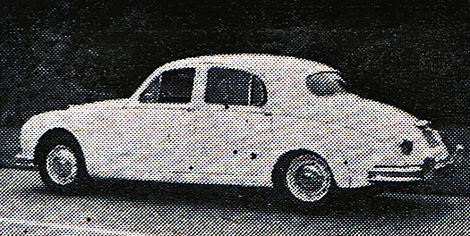 Jaguar 3.4 (current price $4,542 N.Y. POE)
Jaguar 3.4 (current price $4,542 N.Y. POE)
A real automobile enthusiast's automobile is the Jaguar 3.4 sedan - or any other Jaguar, for that matter! With its price falling well into the upper medium price range of American cars its size down in what is considered the compact class in this country, it might be difficult for non-believers to understand the 3.4 sedan's appeal. Basically it stems from a combination of very good performance, superb roadability, fine quality and workmanship. Like many other imported cars, the 3.4 Jaguar can't be compared to any U.S. car because it has no real counterpart over here. The four passenger Thunderbird is perhaps closest to it in price and concept, but the T-Bird is still poles removed from the Jaguar sedan in several important respects. It's interesting to note that while far from cheap, the 3.4 is economical to operate as far as fuel economy is concerned - giving gas mileage comparable to the Lark and American.
Model - 1958 four-door sedan, six-cylinder dohc, water-cooled, 210 cubic inches, 210 hp @ 5500 rpm, dry weight 3,024 lbs, wheelbase 107 inches, four-speed transmission.
Performance figures - gas mileage 20 mpg average, acceleration 0-30 mph 3.65 seconds, 0-45 7.05 seconds, 0-60 10.42 seconds; top speed 120 mph.
 Mercedes 190 SL (current price $5,416 N.Y. POE)
Mercedes 190 SL (current price $5,416 N.Y. POE)
More a sports touring car than one suited for racing, the Mercedes 190 SL roadster is a beautifully styled car of outstandingly high quality. While its performance is plenty adequate for normal driving purposes, stress is on comfort rather than competition. Roadability however is excellent and gives evidence of the competitive breeding in the Mercedes background. Most impressive single thing about the 190 SL is its fabulous high degree of detail finish and overall quality. This can be seen and felt all through the car. Price of this automobile proves once again, that you can't attain this type of perfection at low cost. At more than $5,500 you have to be a true automobile fancier and a wealthy one, to invest in a 190 SL! This makes fuel economy, of which this Mercedes offers a good measure, a bit of an academic question.
Model - 1958 roadster, four-cylinder sohc, water-cooled, 115.74 cubic inches, 120 hp @ 5700 rpm, curb weight 2,515 lbs, wheelbase 94.5 inches, four-speed transmission.
Performance figures - gas mileage 25 mpg @ 60 mph, acceleration 0-30 mph 4.4 seconds, 0-45 8.0 seconds, 0-60 14.2 seconds; top speed approximately 102 mph.
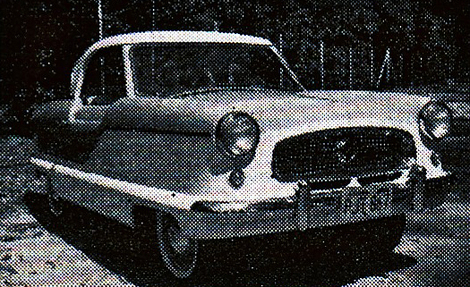 Metropolitan 1500 (current price $1,626 N.Y. POE)
Metropolitan 1500 (current price $1,626 N.Y. POE)
The American Motors Metropolitan is a surprise blend of Anglo-American cooperation, designed here and built in England for sale primarily in the U.S. It carries a relatively low price, although the tab is high enough to put it right up against such four-passenger cars as VW and Dauphine. The Metro's advantages over these more sporting appearance and performance. The car does not have quite the degree of precise handling qualities it should to go along with these features, however, suspension could be firmer, though this would make for a harder ride than the Metropolitan now delivers. Because of its soft ride, jaunty styling, ease of parking and standard three-speed transmission, this little car has proved especially popular as a second car for women. It delivers good fuel economy and the reliable Austin-built four-cylinder engine is another factor in providing low operating costs; servicing is rather simple and parts widely available.
Model - 1958 two-door hardtop coupe, four cylinder ohv, water-cooled, 90.89 cubic inches, 8.3 to 1 compression, 55 hp @ 4600 rpm, test weight 1,900 lbs, wheelbase 85 inches, three-speed transmission.
Performance figures - gas mileage 29 mpg, acceleration 0-30 mph 5.9 seconds, 0-45 11.2 seconds, 0-60 19.5 seconds.
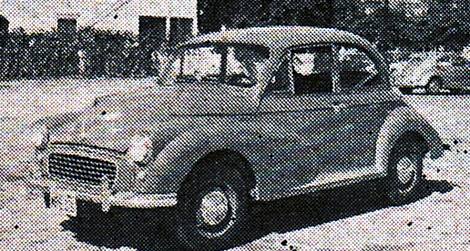 Morris Minor 1000 Deluxe (current price $1,761 N.Y. POE)
Morris Minor 1000 Deluxe (current price $1,761 N.Y. POE)
Economy, a surprisingly good ride and better performance which is a good or better than most of its directly competitive imported brethren are major assets of the Morris Minor 1000. Biggest handicap is styling which is especially the same as when it first appeared a decade ago - and which wasn't particularly fresh even then! Apparently it's this lack of styling, and promotion, which has kept the Minor well in the shade of such cars, which are roughly comparable price-wise as the VW and Dauphine. It generally will accelerate better than either of these and has a slightly higher top speed. With its front engine-rear drive arrangement, it also offers handling characteristics which are more "normal" by U.S. standards. And despite its low cost it has plus features as torsion front suspension, some leather in interior trim.
Model - 1957 two-door sedan, four-cylinder inline ohv, water-cooled , 57.3 cubic inches, 8.3 to 1 compression, 37 hp @ 4750 rpm, curb weight 1,650 lbs, wheelbase 86 inches, four-speed transmission.
Performance figures - gas mileage 35.5 mpg average, acceleration 0-30 mph 6.8 seconds, 0-45 14.5 seconds, 0-60 27.7 seconds; top speed 75 mph.
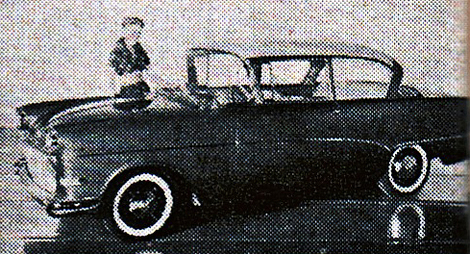 Opel Rekord (current price $1,957.50 N.Y. POE)
Opel Rekord (current price $1,957.50 N.Y. POE)
Detroit's influence can be seen in several ways in the styling of the Opel Rekord. It appears that the car was designed with at least some thought to the American market. Interior roominess ina package of such small overall size is quite surprising. On the other hand, performance is just fair for a car of Opel's weight and engine displacement - something not calculated to endear the car to Americans. This is counter-balanced, however, by the fact that fuel economy is really excellent for a car capable of carrying six people. Overall test average of 27.3 mpg was made during a combination of city and highway driving, and just open road cruising. Handling of the Rekord is not quite up to the standards of several other imported sedans, probably because the U.S. practice of emphasizing soft, smooth ride at some expense to roadability has been followed.
Model - two-door sedan, four-cylinder ohv, water-cooled, 90.3 cubic inches, 7.5 to 1 compression, 56 hp @ 4400 rpm, curb weight 1,995 lbs, wheelbase 110 inches, three-speed transmission.
Performance figures - gas mileage 27.3 mpg average, acceleration 0-30 mph 6.8 seconds, 0-45 12,2 seconds, 0-60 26.7 seconds.
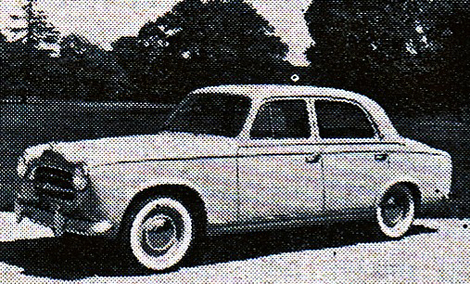 Peugeot 403 (current price $2,175 N.Y. POE)
Peugeot 403 (current price $2,175 N.Y. POE)
Although Peugeot 403 is certainly an economical car in both first operating costs, its conservative - but not unattractive - styling gives it a hint of the look of dignity often associated with imported luxury cars. Nor is this impression limited in styling; quality, appointments and interior comfort offered by the 403 suggest a higher figure than its relatively modest price. Handling is a Peugeot strong point, but excellent roadability has been provided without sacrifice in riding comfort. Performance is adequate for the car's engine size and weight - held down by liberal use of aluminum for such items as the rocker cover, fly wheel housing, etc. Economy is excellent for a car capable of carrying six adults, as the average of 28.4 mpg recorded by the test car shows. Several novel engineering features are included in the Peugeot's design; among them are the worm gear drive which lowers the drive shaft and cuts drive tunnel and integral rocker cover-intake manifold used atop the hemispherical combustion engine.
Model - four-door sedan, four-cylinder ohv, water-cooled, 90 cubic inches, 7 to 1 compression, 58 hp @ 4900 rpm, test weight 2,352 lbs, wheelbase 105 inches, four-speed transmission.
Performance figures - gas mileage 28.4 mpg, acceleration 0-30 mph 4.9 seconds, 0-45 10.8 seconds, 0-60 19.9 seconds; top speed 80 mph.
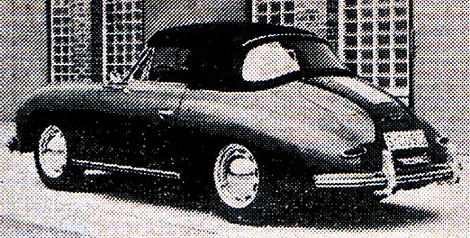 Porsche 1600 Super Speedster (current price $3,615 N.Y. POE)
Porsche 1600 Super Speedster (current price $3,615 N.Y. POE)
Porsche's Super Speedster model ia a typical example of the thoroughbred automobiles built by this German company. It won't appeal to those who buy automobiles on the basis of price-per-pound, but represents the ultimate dream car for a growing number of enthusiasts who appreciate the finer things in automobiles. In handling, overall quality, braking ability and performance-per-cubic-inch, it ranks with the best. These things don't come cheaply however, and Porsche prices reflects this. It is another prime example of the true connoisseur's car - a compact luxury automobile with evidence of careful craftsmanship abd sound engineering showing in every detail. It delivers amazingly good fuel economy in view of its excellent performance. Acceleration is comparable to American cars with engines of more than triple displacement and horsepower ratings. Styling is governed more by function than fashion, with pleasing results except when the soft-top is in place.
Model - 1958 two-door roadster, four-cylinder opposed, air-cooled, 96.5 cubic-inches, 8.5 to 1 compression, 88 hp @ 5000 rpm (minimum), curb weight 1,700 lbs, wheelbase 82.7 inches, dour-speed transmission.
Performance figures - gas mileage 26.9 mpg average, acceleration 0-30 mph on 3.7 seconds, 0-45 7.2 seconds, 0-60m11.4 seconds.
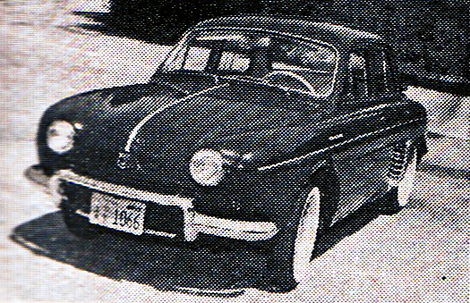 Dauphine (current price $1,645 N.Y. POE)
Dauphine (current price $1,645 N.Y. POE)
Attractiveness of styling is the Renault Dauphine's major sales point of advantage over its most direct competitor the German Volkswagen. Both the French Dauphine and the German VW are reasonably comparable in terms of top speed, acceleration, and fuel economy. Difference occur between individual cars made by the Gallie and Teutonic auto firms, to be sure, but they pretty well balance out in the long run. Experience has shown however that the VW makes up its less attractive buglike appearance by offering better detail finish than the Dauphine. Thus, the question of maximum quality vs. styling appeal seems to be the deciding factor in chosing between the Dauphine and VW. The Dauphine has a number of enthusiastic owners, incidentally, who report that strides in the car's performance have been made since we last tested it and that it will now shade the VW a hit in several areas of acceleration.
Model - 1956 sedan, four-cylinder ohv, water-cooled, 51 cubic inches, 7.25 to 1 compression, 30 hp @ 4200 rpm, curb weight 1,400 lbs, wheelbase 89 inches, three-speed transmission.
Performance figures - gas mileage 51 mpg @ 30 mph, 50 mpg @ 45 mph and 36 mpg @ 60, acceleration 0-30 mph in 8.1 seconds, 0-45 17.2 seconds, 0-60 30.7 seconds; top speed 70 mph.
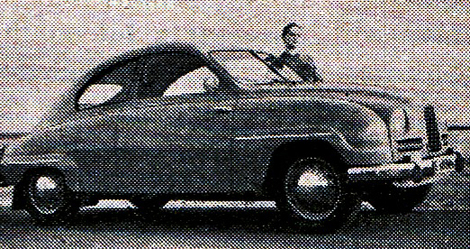 Saab 93 (current price $1,895 N.Y. POE)
Saab 93 (current price $1,895 N.Y. POE)
Unusual enough in both engineering and styling to suit customers with even the most offbeat tastes, the Saab 93 is also a relatively rare car in many sections of the US. This little Swedish car is powered by a small three-cylinder, two-cycle engine, driving the front wheels. Its unusual appearance stems from the fact that it is built by a company whose basic business has been and still is manufacturing of aircraft. The two-stroke powerplant delivers excellent performance considering its 45.6 cubic inches; its biggest drawbacks are a very rough idle and the necessity of mixing oil with gasoline in exactly measured ratios. An even hotter version of the Saab the Gran Tourismo model, with a number of built-in features designed to fit it especially for rallies and similar competitive events is now available. Even the standard 93 model, however, will perform with many makes having one-quarter to one-third larger engines; at the same time giving well over 30 mpg.
Model - two-door sedan, three cylinder two-cycle, water-cooled, 45.6 cubic inches, 7.3 to 1 compression, 38 hp @ 500 rpm, dry weight 1,775 lbs, three-speed transmission.
Performance figures - gas mileage 36.6 mpg, acceleration 0-30 mph in 6.9 seconds, 0-45 15.7 seconds, 0-60 27.8 seconds, top speed 75 mph.
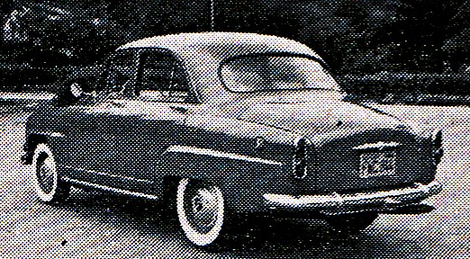 Simca Aronde (current price $1,745 N.Y. POE)
Simca Aronde (current price $1,745 N.Y. POE)
Close to the VW is the four-cylinder Simca models - or at least, this is the consensus of opinion of most imported sedan enthusiasts. You pay something more than $100 for the added convenience of the four-doors (vs. two for VW), the better acceleration (roughly 10 seconds faster 0-60 mph) and highr top speed (by some 12-15 mph) of the Simca Aronde. Relatively conventional with its front engine-rear drive setup. The Simca is a good handling and reasonably high quality import which for some reason has been overlooked so far in many parts of the country. Its honest top speed of about 85 mph and the fact that it can easily at 65 mph all day make it attractive for US driving conditions - and now that Chrysler is behind it. It might get more of the reputation it deserves.
Model - 1958 sedan, four-cylinder ohv, water-cooled, 78 cubic inches, 6.9 to 1 compression, 48 hp @ 4500 rpm, dry weight 1,931 lbs, four-speed transmission.
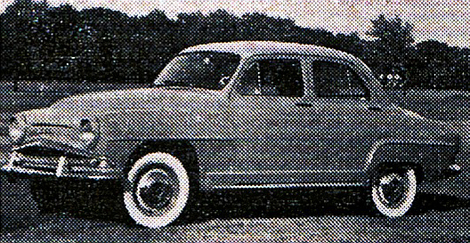 Simca Aronde Montlhery (current price $1,810 N.Y. POE)
Simca Aronde Montlhery (current price $1,810 N.Y. POE)
Use of the 57 hp Flash Special engine in the Simca Montlhery gives roughly 10% better acceleration than earlier Arondes tested with the 48 hp engine. The added power also moves the top speed up to near the 90 mph. The combination of excellent fore-aft weight balance and well engineered suspension which is just a bit on the stiff side has been retained, however, with the result that the Simca is still a joy to handle. Simca styling has been little changed over the years, but has remained highly acceptable because of a lack of non-functional gimmicks. Simplicity of the car's lines have kept it from looking dated despite lack of change. Evidently the power increase has had little adverse effect on fuel economy because the Montlhery tested averaged more than 30 mpg - actually turned in a better average than lower-powered Aronde tested earlier!
Model - 1958 sedan, four-cylinder ohv, water-cooled, 78.72 cubic inches, 7.8 to 1 compression, 57 hp @ 5200 rpm, test weight 2053 lbs, wheelbase 96 inches, four-speed transmission,
Performance figures - gas mileage 31.1 mpg, acceleration 0-30 mph 5.15 seconds, 0-45 10.57 seconds, 0-60 18.33 seconds, top speed 86-90 mph.
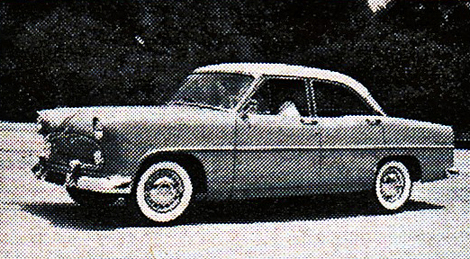 Sinca V-8 (current price $2,199 N.Y. POE)
Sinca V-8 (current price $2,199 N.Y. POE)
Just about the only imported cars using V-8 enginesand selling for anything like reasonable prices which can be afforded by average Americans are Simcas - and they use powerplants which originated in Ford's Dearborn plant! While this doesn't make them extremely modern in concept, it does not kill their desirability completely. The engine Simca uses in each such cases is the reasonable V-8 - 60. When reworked to put out 85 hp, this obsolete but still willing engine is capable of pushing a 2600-lb automobile from zero to 60 mph in 18 seconds and moving it to a top speed of 90 mph. Since the test of the V-8 sedan was completed, Simca has introduced newer and much livelier models using the same powerplant. Their performance varies directly with the weight and power rating as compared to the 1956 model sedan rested, naturally. Gas mileage should never go under 20-22 mpg, however.
Model - 1956 sedan, V-8 L-head, water-cooled, 143 cubic inches, 8 to 1 compression, 85 hp @ 4400 rpm, curb weight 2596 lbs, wheelbase 106 inches, three-speed transmission.
Performance figures - gas mileage 25.4 mpg @ 30 mph, 29.1 mpg @ 45 mph, 19.2 mpg @ 60, acceleration 0-30 mph 5.1 seconds, 0-45 11.4 seconds, 0-60 18 seconds, top speed 90 mph.
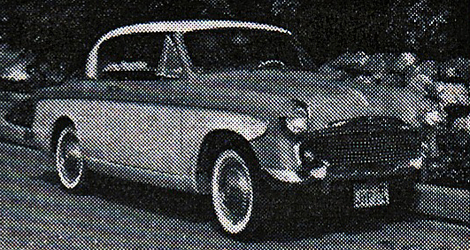 Sunbeam-Rapier (current price $2,499 N.Y. POE)
Sunbeam-Rapier (current price $2,499 N.Y. POE)
It seems apparent that the Sunbeam-Rapier was designed to be an automobile combining desirability family characteristics with those of the sporty-type Gran Turismo models - and with styling features aimed at making it attractive to the U.S. market. This is a rather pretentious order but some of its goals have been realized. It provides more comfort qualities (low noise level, for instant), better detail finish and a number of accessories not found in many cars roughly comparable to the Rapier. Very complete instrumentation is one of its big selling points. Performance and handling are just average for a car of the Sunbeam's size and engine displacement. Styling is quite American in its chromed accents and this may displease some who desire the simplicity of European designers. Discerning buyers would do well to consider this senior member of the Rootes offerings in the U.S. if they are seeking import economy minus foreign austerity.
Model - 1958 two-door hardtop, four-cylinder ohv, liquid-cooled, 91.2 cubic inches, 8.5 to1 compression, 73 hp @ 5200 rpm, test weight 2400 lbs., four-speed transmission.
Performance figures - gas milage 24.8 mpg, acceleration 0-30 mph 5.3 seconds, 0-45 11 seconds, 0-60 19 seconds, top speed 88-90 mph.
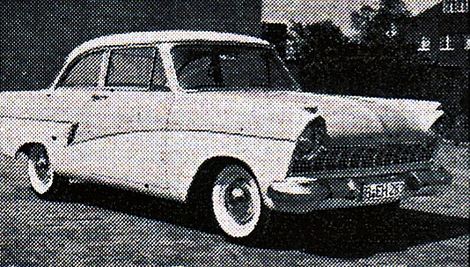 Taunus 17-M Deluxe (current price $2,162 N.Y. POE)
Taunus 17-M Deluxe (current price $2,162 N.Y. POE)
Blending the best of two worlds is no easy task, but in the Taunus 17M an outstanding compromise has been made between typical European and American automobile features. Styling of the car is a hint of its overall character; resemblance of the Taunus silhouette to Dearborn products is bolstered by a Ford-like grille and Mercury-type side trim. Ride and handling are an excellent compromise of the smooth ride U.S. customers demand a high degree of roadability for which imports have become noted. Few cars in the Taunus price range achieve such an admirable balance of riding comfort and good handling characteristics - even though many might be better in one or the other. The same is true of performance and economy. The Taunus isn't really outstanding in either respect, but delivers acceleration better than many imported sedans near its price and is miserly enough with fuel to make it a good buy for those interested in low gas consumption. The car is solid and well put together; shows evidence of quality and good craftsmanship in all important respects.
Model: - 1958 two-door sedan, four cylinder ohv, liquid-cooled, 103.62 cubic inches, 7.1 to 1 compression, 67 hp @ 4400 rpm, test weight 2,447 lbs, three-speed transmission, 3.9 to 1 axle ratio.
Performance figures - gas mileage 25.2 mpg, acceleration 0-30 mph 5.1 seconds, 0-45 9.5 seconds, 0-60 17.4 seconds, top speed 78 mph.
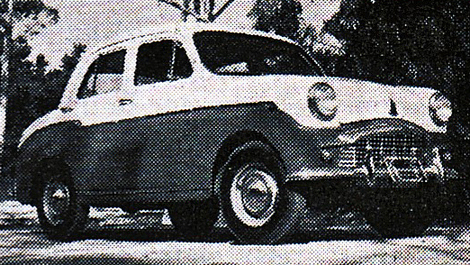 Triumph Sedan (current price $1,699 N.Y. POE)
Triumph Sedan (current price $1,699 N.Y. POE)
Although it offers performance and fuel economy on a par with other makes in its price, size, and displacement class, the Triumph sedan suffers because of the name it bears. Too many expect the little four-door to be a miniature version of the TR sports models which are such favorites here in the U.S. Actually it is a country cousin whose qualities are not styling or zoom but less romantic everyday utility. One of its selling points is a smoother ride than might be expected from a car with an 84-inch wheelbase, but this is paid for in the weaker roadability of a softer suspension. A notable feature is more than adequate trunk space and rear seats that fold down to add capacity. Performance figures are estimations since the test car, one of the first in the area, had not been broken in sufficiently to allow full throttle operation.
Model - 1958 sedan, for-cylinder ohv inlin, water-cooled, 57.8 cubic inches, 8-to-1 compression, 39 hp @ 500 rpm, curb weight 1680 lbs.
Performance figures - gas milage 35-40 mpg (estimated), 0-30 mph 7 seconds, 0-45 15, 0-60 27; top speed (estimated) 73 mph.
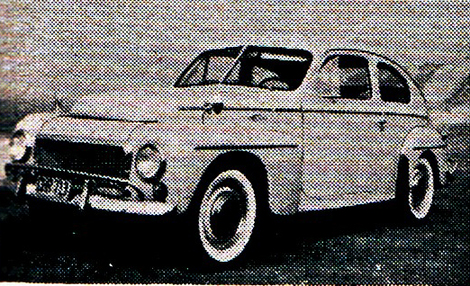 Volvo Deluxe (current price $2,238.53 N.Y. POE)
Volvo Deluxe (current price $2,238.53 N.Y. POE)
Performance of a really outstanding nature is the single most impressive thing about the 85-hp Volvo. The job its conventional four-cylinder engine of 97.6 cubic inches does is little short of phenomenal - giving acceleration better than the average size six-cylinder domestic car and even equal to a number of smaller displacement V-8 models. Add to this a top speed of about 93 mph ability to cruise easily at 65-70 mph and around-town fuel economy of 24-26 mpg and the little pushrod engine deserves even more respect. Although no beauty as far as styling is concerned, the Volvo is ruggedly and honestly built. It is relatively noisy, especially in comparison with U.S. cars, but is one of the solidest and most trouble-free imported cars being shipped into this country. Good roadability has been proven by its excellent competition record, although those familiar with other foreign makes might note a fair amount of body roll in corners at first.
Model - 1958 two-door sedan, four-cylinder ohv, water-cooled, 97.6 cubic-inches, 8.2 to 1 compression, 85 hp, test weight 2315 lbs., wheel-base 102.5 inches, three-speed transmission.
Performance figures - gas milage 22.1 mpg average, acceleration 0-30 mph 4.6 seconds, 0-45 9.6, 0-60 14.2; top speed over 90 mph.
Volvo (Four-Speed Transmission) (current price $2,238.53 N. Y. POE)
Addition of a four-speed transmission to the hot Volvo sedan was almost inevitable; that such a gearbox has been made available as an alternative to the normal three-speed unit at no added cost is a bit surprising. The four-speed transmission does not make a significantly great improvement in the already good acceleration of the Swedish import, but it does make it more versatile and an even better bet for enthusiast-types who are contemplating a bit of competition with their cars. New 1959 Volvos have been introduced since the test of the four-speeder tested, but changes are more detailed than drastic. Obvious visual changes include a one-piece windshield and larger taillights; improved steering is one of the notable engineering revisions. Choice of three or four-speed transmission is continued. Not highly styled nor especially inexpensive, the Volvo has won friends mainly on the basis of excellent quality, exceptional performance and low operating costs.
Model - 1958 tw0-door sedan, four cylinder ohv, liquid-cooled, 97 cubic inches, 8.2 to 1 compression, 85 hp, test weight 2140 lbs., four-speed transmission, 4.56 to 1 axle ratio.
Performance figures - gas milage: 25.5 mpg; acceleration 0-30 mph 4.0 seconds, 0-45 8.12, 0-60 14.2
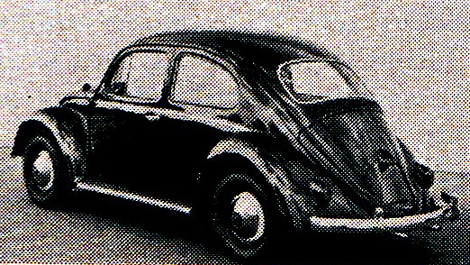 Volkswagen (current price $1,545 N.Y. POE)
Volkswagen (current price $1,545 N.Y. POE)
Here is a car that stands for "import" in the minds of most Americans. On its beetle-back it has carried the cause of economy, compactness and foreign quality to our shores. It's still the champ but not without its weak points. Handling is fairly touchy for the new VW driver. Some of its odd characteristics in this department are blamed mistakenly on the weight factor of its rear engine, but adverse effects are caused to a great degree by the swing axle and the rear drive. Time accustoms the driver to these qualities, however, and he can learn to take corners with ease. Overall roadability is good and economy is definitely above average. Performance up to around 50 mph is about on a par with other small displacement sedans. It begins to bog down a bit between 50 and 60. Cruising speed is the same as "flat out" so that the top speed, which is in the neighborhood of 70 mph, can be held all day long without worry as to engine strain. Piston speed is ridiculously low to guarantee thousands of trouble-free miles. One definite point of complaint is the noise level with-in the Volkswagen cab. There does not seem to be any trick which can deaden the sound of the rear engine. The general quality and reliability are superb while the passenger and storage capacity are not good. The standard four=speed floor shift is one of the greatest. Shifting from gear to gear is smooth and definite. The top three gears are synchromesh and the selection of ratios is above average. Basically the car is a justifiable winner because of sound engineering, high quality and reputation for permanence in styling. Resale values have remained abnormally high and although these figures are stabilizing a bit, the VW remains a sound buy for the man who has been crying the "depreciation blues."
Model - 1958 deluxe sedan, four-cylinder ohv, air cooled, 72 cubic inches, 6.6 to 1 compression, 36 hp, curb weight 1600 lbs., wheelbase 94.5 inches, four-speed transmission.
Performance figures - gas mileage: 30.8 mpg average, acceleration 0-30 mph 6.5 seconds, 0-45 14.9, 0-60 29.7
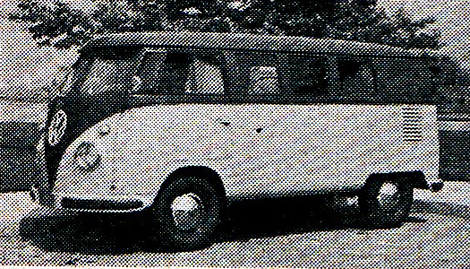 Volkswagen Micro Bus (current price $2,120 N.Y. POE)
Volkswagen Micro Bus (current price $2,120 N.Y. POE)
One of the most functional vehicles extant is the Volkswagen Micro Bus. Admittedly no beauty in appearance, the box-like lines of the Micro Bus enable it to carry a total of eight adults and 16 suitcases - despite the fact that it is more than a foot shorter than the Rambler American! Its non-fashionable six-foot-plus height, rear engine-rear drive arrangement and clever, practical overall design are reasons for this phenomenal capacity. Its shape and poor-weight ratio militate against performance, but the Micro Bus will cruise comfortably and dependably at 50 mph all day long and will deliver fuel economy well in excess of any vehicle with near its load-carrying ability. Another Micro virtue is the easy access to the interior provided by wide-opening doors. Seat arrangement is extremely versatile, can be altered to provide maximum passenger capacity or accommodate large loads. This is a prime example of a vehicle engineered to provide maximum utility at minimum cost.
Model - four-door, four-cylinder ohv, air-cooled, 72 cubic inches, 6.6 to 1 compression, 36 hp @ 3700 rpm, test weight 2447 lbs., wheel base 94.5 inches, four-speed transmission.
Performance figures - gas mileage: 23.6 mpg; acceleration 0-30 mph 11 second, 0-45 26.5, 0-55 36; top speed 55-57 mph.
Posted 10/29/09 @ 01:39 AM | Tags: Motor Life march 1959, Imported cars vs US cars, Austin-Healey 100, Borgward TS, Ford Consul Mark II, Citroen ID-19, DKW, Dyna-Panhard, Fiat 1100, Goggomobil, Goliah 1100, Hillman Minx, Hillman Minx Special, Isetta 600, Jaguar 3.4, Mercedes 190SL, Metropolitan 1500, Morris Minor 1000 Deluxe, Opel Rekord, Peugeot 403, Porsche 1600 Super Speedster, Dauphine, SAAB 93, Simca Aronde, Simca Aronde Monthlhery, Simca V-8, Sunbeam-Rapier, Tanus 17-M Deluxe, Triumph Sedan, Volvo Deluxe, Volkswagen, Volkswagen Micro Bus, Rambler, Lark, Ford, Chevrolet, Plymouth, mini cars, micro cars